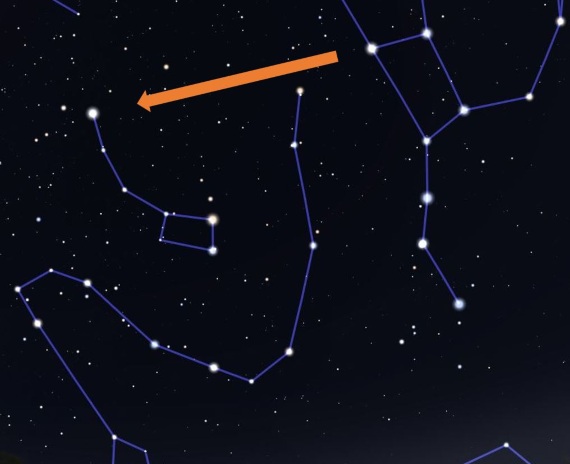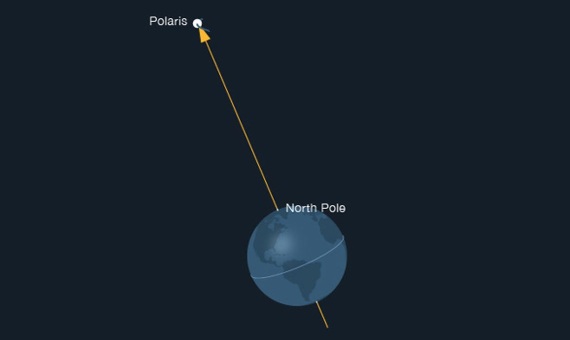It tops almost any list of the most famous stars and constellations in our sky, but the Pole Star is not one of the brightest, like Sirius or Arcturus. Nor does its colour stand out —others like the red giant Antares are much more striking. Nor is it the nearest —that honour goes to Alpha Centauri. So why is it so famous? Why is it called “pole” and where can we locate it?
Although not notable for its brightness, the Pole Star (aka Polaris or the North Star or the Polar Star) is the brightest star in the constellation of Ursa Minor. It can be located relatively easily above the northern cardinal point (so long as we are in the northern hemisphere, because in the southern hemisphere it is not visible).

If we look at the Sun from where it appears in the morning —roughly in the east— we will see that it rises during the morning until reaching its maximum height with the horizon, which we opportunely call midday (since as many hours of daylight have passed as those that remain until sunset). As the afternoon progresses, it descends until reaching the horizon —roughly in the west— and at the end of the day its trajectory has drawn an arc.
If we look at the sky late at night and note the position of the brightest stars, we will see that after a few hours they make the same movement as the Sun: some stars will set in the west, other new ones will rise in the east, and all the stars of the firmament will move following this pattern. All of them? No, all except one: Polaris.
The whole sky revolves around the polar star. Credit: Ryan Messinger
The rotation axis of the sky
The explanation for this immobility of the North Star lies in celestial mechanics: this star is nearly in a direct line with the Earth’s rotation axis in the sky. Imagine a bicycle wheel, a record player with an old LP or any disc that spins. Is there a point where you can put your finger so that it doesn’t move while the disc spins? The trick is to place your finger on the axis of rotation; the speed in the centre is zero and as we move the finger away from the centre the linear speed increases (as the radius of rotation increases).
The Pole Star is in the rotation axis of the sky, which is why it’s the only star that never moves from its spot. If we locate this star and note its position, we can come back in a few hours, days, or years and we will always find it in the same place. The other stars vary their position and will most likely be in other parts of the sky, but Polaris will not have moved.

The only way to see Polaris move from its spot is to travel. If we head south, the further south we go the lower it will appear —closer to the horizon— until we reach the equator, at which point it will be flush with the horizon. When we travel northward, the opposite happens, and the star rises in the sky. At the North Pole a singular event occurs: the Pole Star is seen right at the highest point in the sky, the zenith, hence its name. It is the star that is located in the centre of the sky.
Not only is it a curiosity, but this variation in position depending on the place of observation makes it useful. Observers at the North Pole see it at 90º, those at the equator at 0º and at intermediate latitudes it varies proportionally: the height in degrees of the Pole Star above the horizon always coincides exactly with the geographical latitude.
An infallible compass
In the earliest maritime explorations, the only references that could be used to know one’s position were astronomical ones. The North Star was one of the best: just by looking at it sailors could deduce the four cardinal points (like an infallible compass in the sky) and by calculating its height in the sky one could know the variation in latitude with respect to the port of origin and whether it was to the north or the south. Especially useful in those times was an instrument known as an astrolabe, easy to build, which for centuries helped sailors to know their position in the sea.

Another equally useful instrument is the nocturnal (also called a horologium nocturnum or nocturlabe), which uses the position of Polaris compared to the star Beta Ursae Minoris (formerly named Kochab) to give the solar time at night; it provides the same information as a sundial, but can be used at night.
All this is very useful until one passes the equator, when the North Star is no longer visible, and that is why in the southern hemisphere both the astrolabe and the nocturnal cease to function.
Unfortunately, over the South Pole there is no bright star as well aligned as Polaris, which is just bad luck. But it is always possible to locate the South Celestial Pole if we know how to identify the Southern Cross, which is very close. During the night, this constellation makes a small turn around the South Celestial Pole, which in principle can be a bit confusing… but there is a trick to never lose the South, if we join the Southern Cross with the Magellanic Clouds: a tribute to the importance of astronomy for navigation, and in particular for one of the greatest seafarers of all time, the Portuguese explorer Ferdinand Magellan.
Comments on this publication